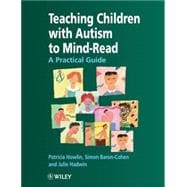
Patricia Howlin is Principal Clinical Psychologist at the Maudsley Hospital, London, working mainly with autistic children and those suffering from pervasive developmental disorders. She is also Senior Lecturer in the Department of Child and Adolescent Psychiatry and Psychology at the Institute of Psychiatry, London. She has been involved in research and treatment with autistic children for many years. Her research interests include a follow-up study of autistic individuals, and a comparison of young autistic adults and a matched group of individuals with severe early language delays.
Simon Baron-Cohen is Professor of Developmental Psychopathology and Director of the Autism Research Centre at Cambridge University, UK, and one of the co-discoverers of the 'theory of mind' deficit in autism. His books include Mindblindness (1995); The Essential Difference (2003); and Autism and Asperger Syndrome: The Facts (2009).
Julie A. Hadwin is Senior Lecturer in Psychology at the University of Southampton. She has used cognitive models to study emotional disorders in childhood and has written several seminal papers to understand attention to threat in childhood anxiety. Her publications include Teaching Children with Autism to Mind-Read (with Patricia Howlin and Simon Baron-Cohen, Wiley, 1999).
|
viii | (1) | |||
|
ix | (2) | |||
| A note to teachers and parents | xi | (1) | |||
| Acknowledgements | xii | ||||
| PART I: INTRODUCTION | 1 | (22) | |||
|
1 | (1) | |||
|
1 | (1) | |||
|
2 | (1) | |||
|
2 | (3) | |||
|
5 | (2) | |||
|
5 | (1) | |||
|
6 | (1) | |||
|
7 | (1) | |||
|
7 | (2) | |||
|
9 | (3) | |||
|
12 | (1) | |||
|
13 | (1) | |||
|
14 | (2) | |||
|
16 | (1) | |||
|
16 | (1) | |||
|
17 | (1) | |||
|
17 | (2) | |||
|
19 | (4) | |||
| PART II: TEACHING ABOUT EMOTIONS | 23 | (210) | |||
|
23 | (1) | |||
|
24 | (2) | |||
|
24 | (1) | |||
|
25 | (1) | |||
|
25 | (1) | |||
|
26 | (2) | |||
|
26 | (1) | |||
|
27 | (1) | |||
|
27 | (1) | |||
|
28 | (51) | |||
|
28 | (1) | |||
|
28 | (1) | |||
|
29 | (1) | |||
|
30 | (49) | |||
|
79 | (51) | |||
|
79 | (1) | |||
|
79 | (1) | |||
|
80 | (1) | |||
|
81 | (49) | |||
|
130 | (103) | |||
|
130 | (2) | |||
|
132 | (2) | |||
|
134 | (1) | |||
|
135 | (98) | |||
| PART III: TEACHING ABOUT INFORMATIONAL STATES | 233 | (26) | |||
|
233 | (1) | |||
|
234 | (3) | |||
|
234 | (1) | |||
|
234 | (2) | |||
|
236 | (1) | |||
|
236 | (1) | |||
|
237 | (3) | |||
|
237 | (1) | |||
|
237 | (2) | |||
|
239 | (1) | |||
|
239 | (1) | |||
|
240 | (5) | |||
|
240 | (2) | |||
|
242 | (2) | |||
|
244 | (1) | |||
|
244 | (1) | |||
|
245 | (4) | |||
|
245 | (2) | |||
|
247 | (1) | |||
|
248 | (1) | |||
|
248 | (1) | |||
|
249 | (10) | |||
|
249 | (5) | |||
|
254 | (2) | |||
|
256 | (2) | |||
|
258 | (1) | |||
| PART IV: DEVELOPING PRETEND PLAY | 259 | (14) | |||
|
259 | (1) | |||
|
260 | (13) | |||
|
260 | (1) | |||
|
261 | (3) | |||
|
261 | (1) | |||
|
262 | (2) | |||
|
264 | (7) | |||
|
264 | (6) | |||
|
270 | (1) | |||
|
271 | (2) | |||
| PART V: FUTURE DIRECTIONS | 273 | (4) | |||
|
273 | (1) | |||
|
273 | (2) | |||
|
275 | (1) | |||
|
275 | (1) | |||
|
276 | (1) | |||
| Appendix: Examples of record forms | 277 |
The New copy of this book will include any supplemental materials advertised. Please check the title of the book to determine if it should include any access cards, study guides, lab manuals, CDs, etc.
The Used, Rental and eBook copies of this book are not guaranteed to include any supplemental materials. Typically, only the book itself is included. This is true even if the title states it includes any access cards, study guides, lab manuals, CDs, etc.